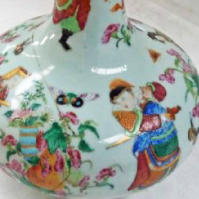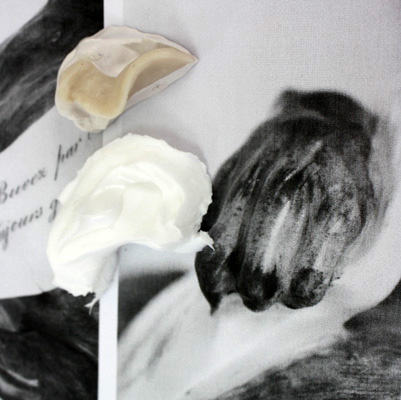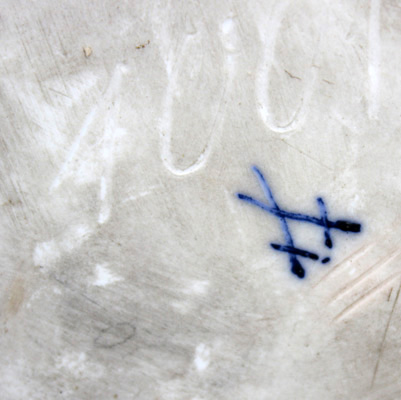




Terminology
Why use a conservator?
It is worthwhile and cost-effective to have valuable (sentimental or monetary) items repaired and restored by a conservator. If you try to repair objects yourself, you may cause more damage to the piece. It is common for owners and amateur restorers to use too much adhesive which then spreads over the surface and becomes hard to remove; also for pieces to slip out of alignment due to inadequate support during the adhesive’s setting time. Subsequent removal of previous repairs by a conservator is time-consuming and adds to the cost of the professional repair.
The sooner a broken item is taken to a conservator, the better. Ceramic and glass will not normally deteriorate whilst awaiting repair, but edges are likely to get dirty and the pieces more vulnerable to further damage if you leave them to one side and forget.
Glossary of Art Conservation Terms
A
Abrasion: Damage to the surface of an object caused by friction such as rubbing or scraping.
Accretion: An opaque material overlaying the surface of an object such as insect droppings, food, adhesives or mold.
Acidic: A condition of having a low pH (less than 7 on a scale of 0 to 14). Acidic substances can cause deterioration and damage to paper objects such as embrittlement, discoloration and fading.
Acid-free: Having a pH of 7 (neutral) or higher (alkaline).
Acid Migration: The movement of acid from one item to another that it is in contact with that has a higher pH, such as from a mount, mat or a backing to the work of art on paper to which it is attached.
Acrylic: A synthetic compound used in materials such as paint, adhesives and coatings.
Adhesive: A substance able to stick two surfaces together.
Alkaline: Having a pH greater than 7.
Alkaline Reserve: An alkaline substance in paper intended to act as a buffer and neutralize acids produced or absorbed by the paper. It can be introduced as part of conservation treatments.
Aqueous: Water-based
Archival Framing: Framing using pH-neutral materials to protect and support the object.
Archival Materials: Material intended to be long lasting due to its high chemical stability, low acid content and inertness. No standards exist that define how long archival materials should survive or maintain their integrity.
Art Conservation: Preservation, repair, and/or stabilization of artworks and other cultural property for the future.
Artist’s Tape: A general-usage pH-neutral paper tape.
ATG Tape: A tape that adheres an adhesive film; used in framing.
B
Binder: A substance that provides cohesion for loose particles.
Binocular Magnification: Magnification produced by a microscope with two eyepieces.
Biological Degradation: Degradation of artworks caused by a biological agent such as mold, insects or rodents.
Break: A split or crack in an item, an image layer or a support.
Brittle: Character of an item that is easily broken, weak or inflexible. In paper items, it is usually associated with high levels of acidity.
C
Calcimine: White or tinted wash for walls
Cellulose: Main component of the fibers of plant material such as wood or cotton that are used to produce paper products.
Chemical Degradation: Degradation of artworks caused by a chemical reaction between the media materials, their environment and the atmosphere.
Coating: A substance such as gelatin, varnish or wax applied to the surface of an object to change or protect it.
Cockling: Distortion or waviness caused by the rippling of an artwork and its support.
Conservation pigments: Chemically stable pigments used for in-painting and other conservation treatments
Conservator: A professional whose primary occupation is the practice of conservation and who, through specialized education, knowledge, training and experience, formulates and implements all the activities of conservation in accordance with an ethical code.
Consolidate: To physically stabilize an object to ensure future stability or so that further treatment procedures can be carried out safely.
Crack: A split or break in an object, image surface or support.
Crease: A line, groove or ridge caused by folding or bending that does not actually break through the surface of the object.
Cultural property: Objects, collections, specimens, structures or sites identified as having artistic, historic, scientific, religious or social significance.
D
Desecator: A sealed container in which objects are placed with solvent for indirect dismantling of previous bonds.
Deacidification: Application of an alkaline solution to neutralize harmful acidic compounds in an object.
Dimensional Distortion: A change or deformation in the evenness of an object’s plane.
Discoloration: A change in color from the original tones and shades.
Dry-cleaning: Removing surface dirt using vinyl, kneaded or rubber erasers, or by brushing or wiping the item with dry brushes or cloths.
E
F
Fading: Localized or overall shifts and changes in colors, pigments and dyes that occurs as a result of exposure to light.
Fill: To replace missing or loss areas in the support or image layer of an object with compatible materials.
Finger Marks: Marks created by the handling of objects that leave oil, dirt or salt residues from perspiration that can reduce image densities and/or cause deformations and discoloration.
Fix: To prevent damage to soluble or loose image materials by applying coatings to the object surface.
Flyspeck: Small dots of fly excretions encrusted onto artworks that can cause staining, weakening and other damage.
Fold: A bend in an object that can lead to cracking, breaking or fragmentation in the image layer or support.
Fragment: Any detached portion or segment of an object.
G
Glazing: A protective transparent material, in some instances made specifically to block out U.V. light. Types: Glass, U.V. Museum Glass, Plexiglass, U.V. Plexiglass.
Glossy: A surface or finish that is smooth and shiny.
Glue: A water-soluble adhesive made of animal protein that contains natural impurities that can cause deterioration and staining of paper and textiles.
H
Humidification: Controlled application of moisture to relax paper items and their supports.
I
In-painting: The process of adding pigment to areas of loss in a work of art, in order to match tone and hue to the original composition.
Indentation: A depression in the plane of an object that doesn’t necessarily break through the surface.
Insect damage: Losses and staining caused by insects feeding off of an object’s compositional material.
J
Jade 403 adhesive: A pH-neutral liquid conservation adhesive.
Japanese Tissue Paper: All-natural, long-fibred paper produced in Japan and used for mending tears and lining paper supports because of its inherent strength and long-term stability.
K
L
Lead abatement: Removal of measures designed to permanently eliminate lead-based paint or lead-based paint hazards from sites
Lead-white paint: A toxic white paint with the chemical formula of carbonate of lead 2PbCO3-Pb(OH)2
Lightfast: Colors or materials designed to undergo minimal or no change when exposed to light
Linen tape: A pH-neutral cloth tape with a water-activated adhesive used for hinging artworks to mats in framing.
Lining process: Supporting and strengthening the original paper or canvas by backing it with a secondary support on the reverse side.
Loss: A missing area in an image or support.
M
Mat: A protective and rigid storage structure, with an opening to allow for the display of the object, used with flat works of art, mostly for framing. Types: book mat, island mat, float mat.
Mat-Burn: Staining or discoloration, found mainly on paper objects, created by acid migration of components in the mat board and corresponding to the frame of its window-opening.
Matte: A surface or finish that is dull, without luster.
Mechanical Damage: Physical damage such as tears or creases that occurs without any accompanying chemical change in the object.
Mechanical Unmounting: Separation of an image from its support without solvent through the process of delamination.
Methyl Cellulose: A clear, water-soluble emulsion produced from modified cellulose and used and as adhesive and consolidant due to its chemical stability and reversibility.
Mold: Minute organisms that grow and feed on organic matter in high humidity conditions that can cause staining and weakening.
Mount: A support or setting for a work of art that serves both structural and aesthetic purposes.
Mounting: Adhering or attaching an object to a support.
Museum board: A pH-neutral mounting board made from 100% cotton rag.
Museum quality: A term used to designate material of a high quality, particularly in terms of treatment or archival matters, although no qualifying standards exist for its use.
Mylar: A brand name for a type of polyester terephtahalate film.
N
Nonaqueous adhesive: An adhesive substance that is not water-soluble
Non-yellowing varnish: Clear-drying liquid sprayed or painted on the surface of an artwork as a protective layer that is formulated not to yellow or darken with time
O
Organic solvents: Solvents with formulas of carbon, hydrogen and oxygen
P
Palette Knife: Utensil with a thin, flexible blade
Photo Corner: Item used to temporarily attach an artwork to a mounting without the use of hinges.
Physical Degradation: Degradation of artworks caused by physical means such as handling or moving.
Poultice Paste: A soft, moist substance used for cleaning and other conservation treatments
Preservation: The protection of cultural property through activities that minimize chemical and physical deterioration and damage and that prevent loss of informational content with the aim of prolonging the existence of the object.
Q
R
Ren-weld adhesive: A reversible epoxy-based adhesive
Restoration: Treatment procedures intended to return cultural property to a known or assumed state, often through the addition of non-original material.
Retouching: Process of adding new details or touches to artwork for correction or improvement
Reversible: Removable without risk of damage to the artwork
S
Spatula: Small tool with a broad, flat, flexible blade used to mix, spread or lift material
Stabilization: Treatment procedures aimed at minimizing deterioration while maintaining the integrity of the object.
T
Treatment: The deliberate alteration of the chemical and/or physical aspects of cultural property in order to prolong its existence, which may consist of stabilization and/or restoration.
U
W
Wallpaper paste adhesive: A water-based adhesive
X
Y
Z